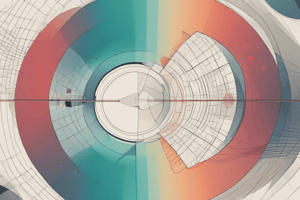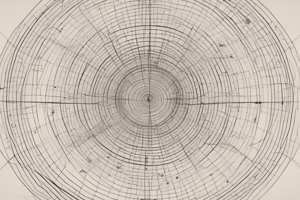Podcast
Questions and Answers
What represents the center of a circle in its standard form equation?
What represents the center of a circle in its standard form equation?
- (r, r)
- (A, B)
- (x, y)
- (h, k) (correct)
Which of the following is the general form of a circle's equation?
Which of the following is the general form of a circle's equation?
- (x - h)^2 + (y - k)^2 = r^2
- x^2 + y^2 - r^2 = 0
- Ax^2 + Ay^2 + Bx + Cy + D = 0 (correct)
- x^2 + y^2 = r^2
What method can be used to convert a general form circle equation to standard form?
What method can be used to convert a general form circle equation to standard form?
- Substitution
- Completing the square (correct)
- Graphing
- Factoring
How can one determine the radius of a circle from its standard form equation?
How can one determine the radius of a circle from its standard form equation?
In geometry, what does it mean for all points on a circle?
In geometry, what does it mean for all points on a circle?
Flashcards are hidden until you start studying
Study Notes
Equation of a Circle
Standard Form
- The standard form of a circle's equation is:
- ((x - h)^2 + (y - k)^2 = r^2)
- Key components:
- ((h, k)): Center of the circle
- (r): Radius of the circle
- Example:
- For a circle centered at (3, -2) with a radius of 4:
- ((x - 3)^2 + (y + 2)^2 = 16)
- For a circle centered at (3, -2) with a radius of 4:
General Form
- The general form of a circle's equation is:
- (Ax^2 + Ay^2 + Bx + Cy + D = 0)
- Key characteristics:
- (A) must equal (1) for it to define a circle.
- Can convert from general to standard form by completing the square.
- Example:
- Start with (x^2 + y^2 - 6x - 8y + 9 = 0), complete the square to find the center and radius.
Applications in Geometry
- Finding the Circle's Center and Radius:
- Use standard form to easily identify center ((h, k)) and radius (r).
- Intersections with Lines:
- Circles can intersect with lines, creating points that can be found by solving the resulting equations simultaneously.
- Circle Properties:
- All points on the circle are equidistant from the center. Useful in constructions and proofs.
- Coordinate Geometry:
- Analyze relationships between points and circles using distance formulas and coordinate transformations.
- Tangents:
- Equation of a tangent line to a circle can be derived using known points and the gradient (slope) of the radius at that point.
- Real-world Applications:
- Modeling circular objects, analyzing orbits, and designing circular layouts in architecture and engineering.
Equation of a Circle
- The standard form of a circle's equation is ((x - h)^2 + (y - k)^2 = r^2), where ((h, k)) represents the center of the circle and (r) is the radius.
- The general form of a circle's equation is (Ax^2 + Ay^2 + Bx + Cy + D = 0), with (A) being equal to (1).
- The standard form can be derived from the general form by completing the square.
- The center and radius of a circle can be directly identified using the standard form of its equation.
- The relationship between a line and a circle can be analyzed by finding the points of intersection, which involves solving the equations simultaneously.
- The distance formula can be utilized to express the relationship between points on a circle and its center.
- The equation of a tangent line to a circle can be derived using the gradient of the radius at the point of tangency.
- Circles find applications in various fields like modeling circular objects, analyzing orbits, and designing circular layouts.
Studying That Suits You
Use AI to generate personalized quizzes and flashcards to suit your learning preferences.




